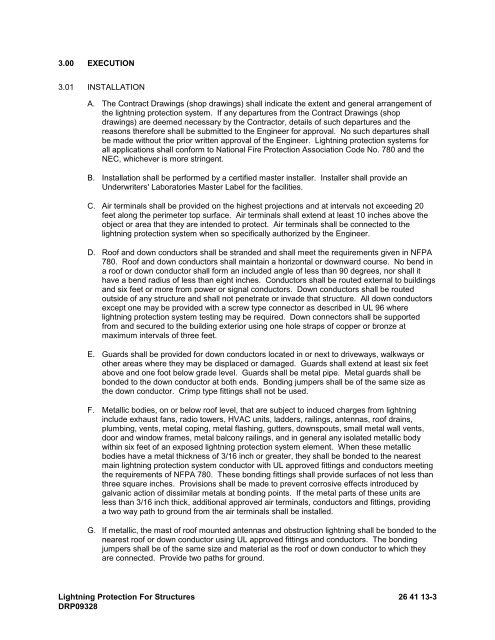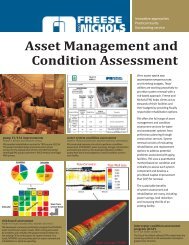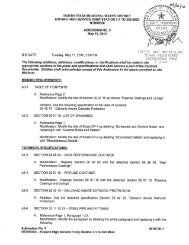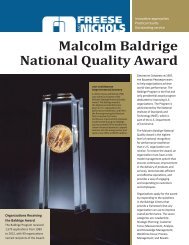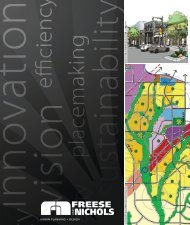final bid specs 09328.pdf - Freese and Nichols, Inc.
final bid specs 09328.pdf - Freese and Nichols, Inc.
final bid specs 09328.pdf - Freese and Nichols, Inc.
Create successful ePaper yourself
Turn your PDF publications into a flip-book with our unique Google optimized e-Paper software.
3.00 EXECUTION<br />
3.01 INSTALLATION<br />
A. The Contract Drawings (shop drawings) shall indicate the extent <strong>and</strong> general arrangement of<br />
the lightning protection system. If any departures from the Contract Drawings (shop<br />
drawings) are deemed necessary by the Contractor, details of such departures <strong>and</strong> the<br />
reasons therefore shall be submitted to the Engineer for approval. No such departures shall<br />
be made without the prior written approval of the Engineer. Lightning protection systems for<br />
all applications shall conform to National Fire Protection Association Code No. 780 <strong>and</strong> the<br />
NEC, whichever is more stringent.<br />
B. Installation shall be performed by a certified master installer. Installer shall provide an<br />
Underwriters' Laboratories Master Label for the facilities.<br />
C. Air terminals shall be provided on the highest projections <strong>and</strong> at intervals not exceeding 20<br />
feet along the perimeter top surface. Air terminals shall extend at least 10 inches above the<br />
object or area that they are intended to protect. Air terminals shall be connected to the<br />
lightning protection system when so specifically authorized by the Engineer.<br />
D. Roof <strong>and</strong> down conductors shall be str<strong>and</strong>ed <strong>and</strong> shall meet the requirements given in NFPA<br />
780. Roof <strong>and</strong> down conductors shall maintain a horizontal or downward course. No bend in<br />
a roof or down conductor shall form an included angle of less than 90 degrees, nor shall it<br />
have a bend radius of less than eight inches. Conductors shall be routed external to buildings<br />
<strong>and</strong> six feet or more from power or signal conductors. Down conductors shall be routed<br />
outside of any structure <strong>and</strong> shall not penetrate or invade that structure. All down conductors<br />
except one may be provided with a screw type connector as described in UL 96 where<br />
lightning protection system testing may be required. Down connectors shall be supported<br />
from <strong>and</strong> secured to the building exterior using one hole straps of copper or bronze at<br />
maximum intervals of three feet.<br />
E. Guards shall be provided for down conductors located in or next to driveways, walkways or<br />
other areas where they may be displaced or damaged. Guards shall extend at least six feet<br />
above <strong>and</strong> one foot below grade level. Guards shall be metal pipe. Metal guards shall be<br />
bonded to the down conductor at both ends. Bonding jumpers shall be of the same size as<br />
the down conductor. Crimp type fittings shall not be used.<br />
F. Metallic bodies, on or below roof level, that are subject to induced charges from lightning<br />
include exhaust fans, radio towers, HVAC units, ladders, railings, antennas, roof drains,<br />
plumbing, vents, metal coping, metal flashing, gutters, downspouts, small metal wall vents,<br />
door <strong>and</strong> window frames, metal balcony railings, <strong>and</strong> in general any isolated metallic body<br />
within six feet of an exposed lightning protection system element. When these metallic<br />
bodies have a metal thickness of 3/16 inch or greater, they shall be bonded to the nearest<br />
main lightning protection system conductor with UL approved fittings <strong>and</strong> conductors meeting<br />
the requirements of NFPA 780. These bonding fittings shall provide surfaces of not less than<br />
three square inches. Provisions shall be made to prevent corrosive effects introduced by<br />
galvanic action of dissimilar metals at bonding points. If the metal parts of these units are<br />
less than 3/16 inch thick, additional approved air terminals, conductors <strong>and</strong> fittings, providing<br />
a two way path to ground from the air terminals shall be installed.<br />
G. If metallic, the mast of roof mounted antennas <strong>and</strong> obstruction lightning shall be bonded to the<br />
nearest roof or down conductor using UL approved fittings <strong>and</strong> conductors. The bonding<br />
jumpers shall be of the same size <strong>and</strong> material as the roof or down conductor to which they<br />
are connected. Provide two paths for ground.<br />
Lightning Protection For Structures 26 41 13-3<br />
DRP09328


